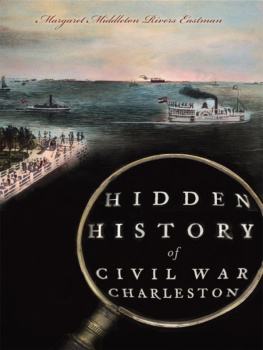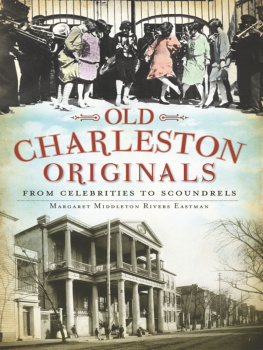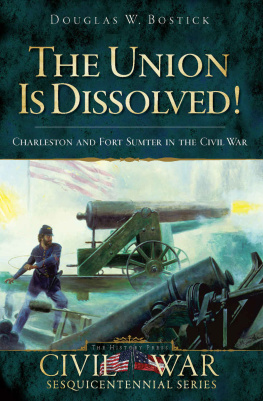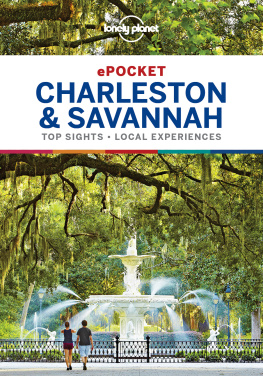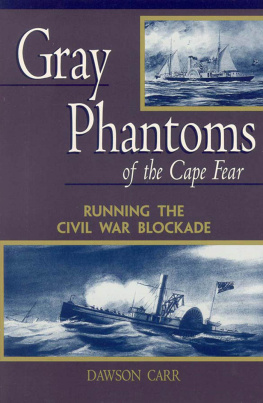
Published by The History Press
Charleston, SC 29403
www.historypress.net
Copyright 2012 by Margaret M.R. Eastman
All rights reserved
Cover: Hand-tinted photograph of the bombardment of Fort Sumter on April 12, 1861.
Courtesy Charleston Museum, Charleston, South Carolina.
First published 2012
e-book edition 2012
ISBN 978.1.61423.617.7
print ISBN 978.1.60949.574.9
Library of Congress CIP data applied for.
Notice: The information in this book is true and complete to the best of our knowledge. It is offered without guarantee on the part of the author or The History Press. The author and The History Press disclaim all liability in connection with the use of this book.
All rights reserved. No part of this book may be reproduced or transmitted in any form whatsoever without prior written permission from the publisher except in the case of brief quotations embodied in critical articles and reviews.
Dedicated to my family with much love
Contents

Photographs of the Federal Navy, and seaborne expeditions against the Atlantic Coast of the Confederacy, specifically of Charleston, S.C. 1863-1865. General Gillmores success at Fort Pulaski earned him the conduct of a much more difficult undertaking: the reduction of the defenses of Charleston Harbor, with the aid of a squadron under Rear Adm. John A. Dahlgren. Operations began early in July 1863; by October hard work and heavy losses had reduced Fort Wagner and Battery Gregg (renamed Fort Putnam by the Federals) on Morris Island, and had silenced Fort Sumter. But no further progress was made until February 18, 1865, when Gen. William T. Shermans approach overland brought about the evacuation of Charleston. The photographers who came to record the flag-raising ceremony at Fort Sumter on April 14, 1865, just 4 years after the surrender with which the Civil War opened, thoroughly documented the forts, Federal and Confederate, and the lovely old city, which fortunately had received only limited damage. Library of Congress.
Appreciation
My son, Robert Eastman, who has acted as my literary agent.
My grandmother, Margaret Simons Middleton, a published historian, who recorded the Middleton family history.
Dorothy Middleton Anderson, who published Charles Francis Middletons letters in the Bermuda Quarterly.
Philip A. Middleton, a history buff in his own right, who first provided a story about the blockade runner Lelia and verified recollections of family traditions.
Edward FitzSimons Good, for full access to his grandmothers research now housed at the College of Charleston Special Collections Library.
Charles Witte Waring III, executive director of the Charleston Mercury, for invaluable assistance.
Amelia P. Cathcart and Paul Cathcart for providing the heroic acts of CSA Lieutenant Colonel William Richard Cathcart, South Carolina Militia.
James Delgado, distinguished author and maritime archeologist, for sharing his research about the Mary Celestia.
Richard Harris and Robert Thorpe for contributing information about the Miller family, Liverpool shipbuilding and the blockade runners Mary Celestia and Lelia.
Chris Michael, author of Lelia, for clarifications on the ships history.
Robert and Suzanne Miller for sleuthing the Crenshaw brothers while on vacation in Richmond.
Ethel Nepveux for information about George Alfred Trenholm and his maritime empire.
Marguerite Palmer and Jack Simmons for their research on Amarinthia Yates Snowden.
Marie Ferrara, Claire Fund, Anne Bennett, Harlan Green, Angela Flenner, Deborah Larsen, Sam Stewart and John White at the College of Charleston Special Collections Library, who have provided a repository for my research and assisted in too many ways to count.
The delightful gang at The History Press: Jessica Berzon, Katie Parry, Daniel Watson, Adam Ferrell, Darcy Mahan, Sophia Russell and Natasha Walsh.
Carl Borick, assistant director; Jennifer Scheetz, archivist; and Jan Hiester, registrar, of the Charleston Museum for continued assistance.
To those who helped along the way: Wayne Braverman, Michael D. Coker, Beth Dickson, Richard Donohoe, Chet Hearn, Robert H. Lockwood, Cheryl (CC) Paul, Robert Salvo and Robert Stockton.
CHAPTER 1
The Election of 1860
By 1860, the Union was in a grave state of political unrest. Proslavery and antislavery factions had been at odds for decades, and emotions ran high across the land. In addition, the alignment of the major political parties had changed. Although the Democratic Party still dominated national politics, there was virtually no opposition from the once-influential Whig Party, which had been founded in 1830 to counter the policies of President Andrew Jackson.
During its heyday, Whig Party membership had included Henry Clay, Daniel Webster, Abraham Lincoln and Horace Greely, editor of the New York Tribune. Two Whig candidates were elected president: William Henry Harrison and Zachary Taylor. Both Whig presidents died while in office, and neither vice president who succeeded them as president was reelected. The Whig Party met its demise in the mid-1850s due to internal disagreements over slavery and the rights of slave owners in the territories. The political vacuum was filled by the new Republican Party, founded in 1854 in opposition to the Kansas-Nebraska Act, which repealed the Missouri Compromise that had kept slavery out of Kansas.
Another group that surfaced during the 1850s was a radical group of proslavery secessionists. The groups politics had been influenced by John C. Calhoun, whose oratory on nullification and states rights had helped create in the Southern psyche a disregard for a strong central government. Called fire-eaters by Northerners, these radicals urged Southern states to create a separate nation that would protect slavery and their way of life. Fearing a shift in the national balance of power as waves of new immigrants arrived from Europe, their oratory became more impassioned as the decade progressed. Better-known fire-eaters were: South Carolinians Robert Barnwell Rhett and his son Robert Barnwell Rhett Jr.; Louis T. Wigfall, originally from Edgefield, South Carolina, who had moved to Texas in 1848; the silver-tongued orator from Alabama, William Lowndes Yancey, a descendant of the South Carolina Lowndes; and Edmund Ruffin, a Virginian who is sometimes erroneously credited with firing the first shot of the war.

SPLITTING THE DEMOCRATIC PARTY
The election of 1860 got off to a bad start. To placate Southerners after their candidate lost the nomination at the 1856 convention, Northern Democrats had selected Charleston, South Carolina, for their national convention. Initially, it seemed a good choice. Charleston was an urbane port town with a population of forty-three thousand. It was also simmering with sectionalism, difficult to get to and the local hostelries were incapable of accommodating the enormous influx of delegates that arrived by sea, coach and train.
The delegates began arriving on April 18. Those from New York, Pennsylvania and Massachusetts came on chartered steamboats that provided their food and sleeping accommodations. Those who journeyed by rail from Washington had to switch trains six times, dragging their baggage with them as they transferred from one set of tracks to another when the gauge changed. The spring weather had been chilly, and the delegates who left Washington were dressed in heavy woolen clothing. It was unfortunate that it was unseasonably hot and humid when the exhausted travelers finally reached Charleston.
Next page
